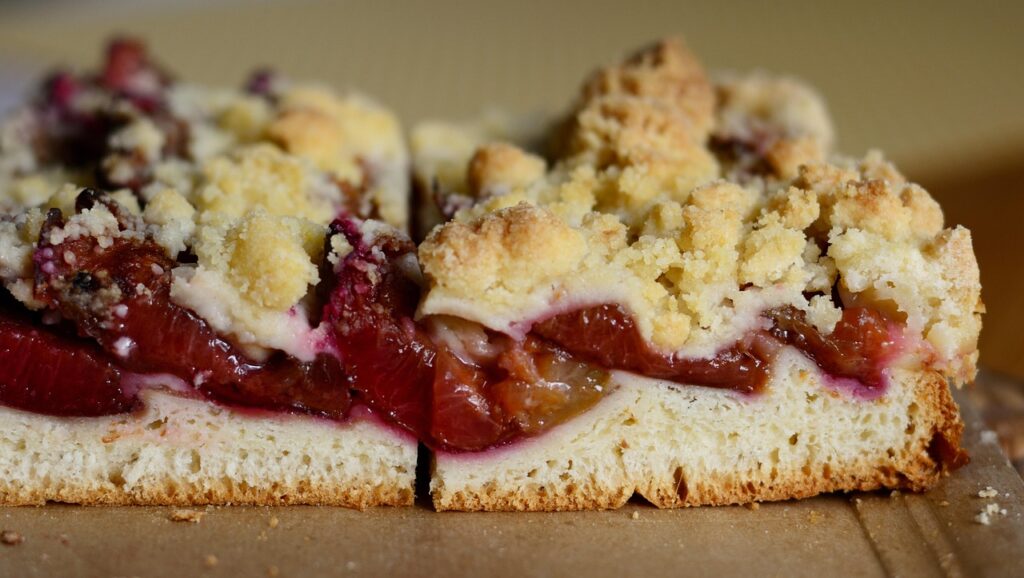The first time I baked this, I got overexcited about the plums. They were perfect—juicy, deep purple, the kind that practically wink at you from the fruit bowl. But I went overboard. The middle of the cake collapsed into a soggy mess, the crumble topping slid off like an avalanche, and the whole thing resembled a dessert crime scene.
After a few tweaks (and a lot of paper towels), I cracked the code. Small fruit pieces, balanced layers, and a gentle bake were the secrets. Now? It’s my end-of-summer staple—especially when you want something simple but special with a cup of tea.
Why This Cake Actually Works
This one’s got layers—literally. A buttery sponge on the bottom, jammy fruit in the middle, and a crisp, golden oat crumble on top. The texture contrast is magic. You get moist cake, sweet-tart plums, and a toasty crunch in every bite.
Bonus points: a little self-raising flour in the crumble topping adds a subtle lift, so it’s not heavy. And the lemon zest? Don’t skip it. It brightens everything and keeps the sweetness in check.
Ingredients & What They Bring to the Party
- Self-Raising Flour (300g + 40g): Lifts both sponge and crumble without fuss.
- Butter (150g melted + 20g soft): Moisture for the cake, richness for the topping.
- Caster Sugar (225g): Sweet but not cloying—perfect for the sponge.
- Demerara Sugar (40g): Crunchy, caramel flavour in the topping.
- Porridge Oats (2 tbsp): Add chew and golden edges to the crumble.
- Plums (300g, chopped small): Juicy and sweet-tart—but don’t go overboard.
- Lemon Zest: Lifts the whole cake and adds freshness.
Make It Your Way (Safely)
- No plums? Swap in chopped apricots or a handful of blueberries—just keep the fruit light.
- Want more crunch? Add a tablespoon of chopped almonds to the crumble.
- No oats? Skip them and use an extra tablespoon of flour instead.
Baking Blunders & How to Avoid Them
| What Went Wrong | Why It Happens | How to Fix It |
|---|---|---|
| Cake soggy in centre | Plums too big or too juicy | Chop plums small and don’t overload |
| Crumble topping slid off | Topping too loose or cake too warm | Lightly press the topping before baking |
| Cake stuck to tin | Tin wasn’t properly greased | Grease and line base carefully |
How to Make Mary Berry’s Plum Crumble Cake (Properly)
- Preheat & Prep
Heat oven to 180°C (160°C fan). Grease and line a deep 20cm springform tin. - Make the Batter
Combine 300g flour, caster sugar, lemon zest, eggs, and melted butter. Stir until smooth. - Layer It Up
Spoon half the batter into the tin. Scatter chopped plums evenly. Spread the rest of the batter on top. - Make the Crumble
Rub soft butter into 40g flour. Stir in demerara sugar and oats for texture. - Top It Off
Sprinkle crumble over the cake. Press it in gently so it sticks. - Bake
Bake for 1 to 1¼ hours. It should be golden and pass the skewer test. - Cool Down
Let the cake cool in the tin for 10–15 minutes before removing. Best served warm or at room temp with something creamy.
Tips From My Kitchen
- Dice plums small—under 1cm—to avoid sogginess.
- Run a knife around the tin before unlocking the springform.
- This cake tastes even better the next day after resting.
- Bake on the lower oven shelf to avoid a soggy bottom.
Storage & Serving
- Fridge: Keeps in an airtight container for up to 3 days.
- Freezer: Freeze slices individually for up to 3 months.
- To Reheat: Microwave for 20–30 seconds or let it come to room temp.
- Best With: Warm custard, vanilla ice cream, or thick Greek yogurt.
FAQs
Q: Can I use ground ginger instead of lemon?
A: You can, but it’s not the same. If you must, use only ¼ tsp—lemon gives it life.
Q: My veg didn’t brown in the oven—why?
A: Probably overcrowded your tray. Use two trays for even roasting.
Q: Can I make this in advance?
A: Yes! It keeps well and actually slices better the next day.
Q: Can I add cream or milk to the batter?
A: No need—but serving it with a splash of cream on the side is heavenly.
More Recipes to Try Next
- Mary Berry Sultana Tea Loaf
- Mary Berry Plum Crumble
- Devil’s Food Cake (Inspired by Mary Berry)








